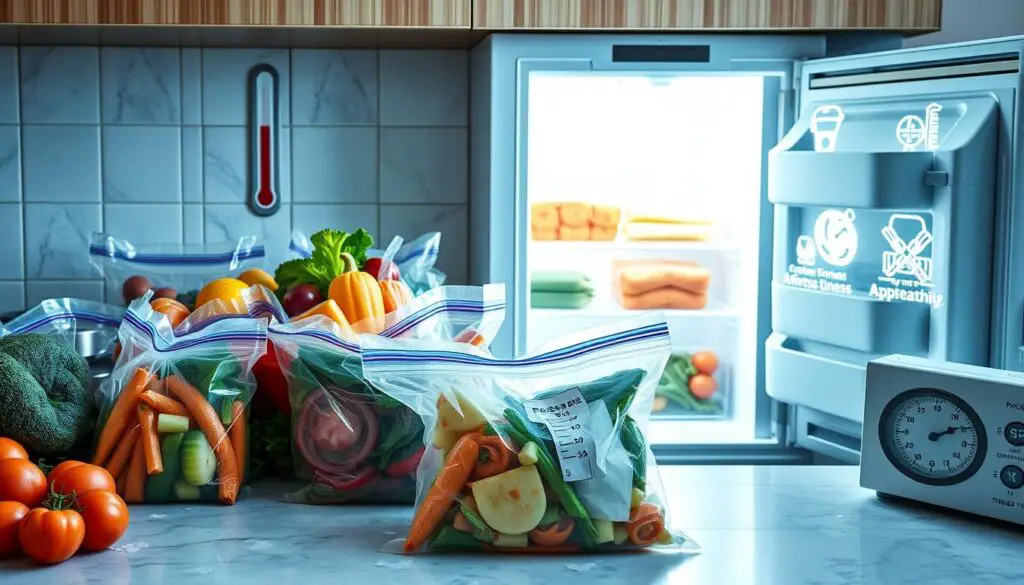At times, frozen foods thaw due to delays, power outages, or cooking plan changes. Food safety experts say you can refreeze frozen food that has thawed. This includes raw or cooked items, but quality might decrease due to moisture loss.
To safely refreeze, the thawed food must stay cold at 40 degrees or below for 3-4 days. If food is fully thawed, warmed, or left out for over 2 hours, it’s best to throw it away for safety.
What Happens When Frozen Vegetables Thaw?
Refreezing frozen vegetables can be tricky. Thawing can change their texture, flavor, and look. Even if ice crystals are left, the effects of thawing on frozen vegetables are key to know before refreezing.
Understanding the Effects of Thawing on Frozen Produce
Most frozen veggies can be safely refrozen in 3-4 days if thawed and cooked. But, their taste might not be as good after refreezing. The changes in frozen produce from thawing can lower the quality of thawed frozen veggies.
- Thawed frozen vegetables often lose much of their texture, flavor, and appearance, even if ice crystals are present.
- Thawed fruit and fruit juice concentrates can also be refrozen if they taste and smell good, but they too will suffer in appearance, flavor, and texture.
- Breads, cookies, and similar bakery items can be safely refrozen, but the end product is likely to be a drier, lower-quality product.
Knowing these effects of thawing on frozen vegetables helps make better choices about refreezing. This way, you can keep your frozen produce quality high.
Is It Safe to Refreeze Thawed Frozen Vegetables?
Many people wonder if it’s okay to refreeze thawed frozen vegetables. Food safety experts say it’s safe to do so, as long as you follow some rules.
The main thing is how and for how long you thaw the vegetables. If they thawed at 40 degrees Fahrenheit or below for 3-4 days, you can refreeze them. But, if they’ve been at room temperature or out for over 2 hours, it’s best to throw them away.
Not all frozen foods can be safely refrozen. For example, ice cream and similar desserts should not be refrozen. They might lose their texture and taste.
“Frozen foods can be kept in the freezer indefinitely, but the quality may degrade over time. Fresh, whole roasts, steaks, and whole chickens can maintain quality for up to a year, while meats cut into pieces may lose quality after four to six months.”
To keep your refrozen thawed frozen vegetables safe, follow food safety rules. Always put safety first and then think about the quality loss. Some foods might not be worth refreezing because of quality loss. But, others can be safely refrozen without harming their food safety.
Can You Refreeze Frozen Vegetables?
When Refreezing Frozen Vegetables Is Okay
Food safety rules say you can refreeze veggies that thawed a bit. They must stay at 40 degrees or below for 3-4 days. But, refreezing can make them less tasty, softer, and less appealing.
It’s better to cook thawed veggies right away. This way, you avoid losing their quality.
Freezing and thawing can cause veggies to lose moisture. This happens because air gets in and moisture evaporates. To keep this from happening, use airtight containers or freezer bags.
It’s okay to refreeze food that was thawed safely in the fridge. But, if it’s been at room temperature for over two hours, or tastes bad, throw it away.
- Safe for refreezing: peas, corn, potatoes, carrots, broccoli.
- Not safe for refreezing: asparagus, parsley, celery, cucumber, lettuce.
To keep refrozen veggies safe and good, keep your freezer at 40 degrees Fahrenheit. Use airtight packaging to prevent moisture loss and air exposure.
Remember, thawed food must stay cold at 40 degrees or below for 3-4 days to be safe to refreeze. If it’s fully thawed, warmed up, or left out too long, it’s not safe to eat.
Factors That Affect Refreezing Frozen Vegetables Safely
Refreezing frozen vegetables is a good way to save food. But, it’s important to do it safely. Temperature and time are key. Experts say thawed veggies should stay at 40°F or below for 3-4 days before refreezing.
If thawed food gets too warm, it’s not safe to refreeze. Food safety rules say to toss it if it’s been at room temperature for over 2 hours. This is because bacteria can grow fast in the “danger zone” of 40°F to 140°F.
Temperature, Time, and Other Crucial Considerations
Other things matter too when you refreeze veggies. How full your freezer is, the type of food, and how well your freezer keeps cold are important. Foods like meat, fish, and soup can be refrozen if they stay cold.
But, some foods don’t refreeze well. These include ice cream, cheese, and fruits and veggies. They might not stay as good as they were before.
- Thawing in the fridge is best, taking 6 hours to a few days.
- Thawing in cold water takes about 3 hours, changing water every 30 minutes.
- The microwave is quick but lowers food quality. Cook it right away to avoid warm spots.
Don’t refreeze food that has been at room temperature for over two hours or above 90°F for over an hour.

“Perishable foods like meat, fish, and soup should be refrozen only if kept at a temperature below 40°F.”
By following these guidelines, you can safely refreeze your veggies, keeping their quality and nutritional value.
Preserving Quality When Refreezing Frozen Vegetables
Refreezing frozen vegetables can be tricky. They often lose texture, flavor, and look. To keep them good, cook thawed veggies immediately or mix them into soups and stews. Then, you can refreeze the soups or stews.
Act fast when refreezing veggies. The quicker you do it, the better they’ll stay. Put thawed veggies in the coldest freezer spot to keep them fresh.
Tips for Retaining Texture and Flavor
- Refreeze vegetables as soon as possible, ideally within 3-4 days of thawing.
- Avoid letting thawed vegetables sit at room temperature for more than 2 hours before refreezing.
- Divide larger portions into smaller, manageable sizes before refreezing to expedite the process.
- Ensure the freezer is set to the optimal temperature (0°F or below) to minimize quality degradation.
Follow these tips to keep your frozen veggies tasty and fresh. This way, you’ll enjoy them even after freezing and thawing.
“Refreezing should be done as quickly as possible and the food should be placed in the coldest part of the freezer.”
Best Practices for Refreezing Frozen Vegetables
Refreezing frozen vegetables can help you save food and money. But, it’s important to do it right to keep your food safe and tasty. Here’s a simple guide to refreeze your veggies safely:
Step-by-Step Guide to Refreezing Safely
- Check the Condition: Make sure the veggies are firm and cold. They should have ice crystals and feel cold.
- Use a Food Thermometer: Check the veggies’ temperature. They should be at or below 40°F (4°C) to refreeze safely.
- Repackage Properly: Move thawed veggies to airtight containers or bags. This stops air and freezer burn.
- Freeze Promptly: Put the veggies back in the freezer fast. Keep them at 0°F (-18°C) or below.
- Label and Date: Write what’s inside and when you refroze it. This helps you know how fresh they are.
By following these steps, your refrozen veggies will stay good. Remember, keeping your freezer at the right temperature and not opening it too much also helps.
| Frozen Food Item | Maximum Freezer Storage Time |
|---|---|
| Processed Foods (Sausage, Hot Dogs, etc.) | Up to 2 months |
| Homemade Leftovers (Casseroles, Soups, etc.) | About 3 months |
| Fresh Poultry (Chicken, Lamb, Beef, Pork, Veal) | 6 months to 1 year |
| Ground Beef | Up to 4 months |
By following these tips, you can keep your frozen veggies fresh longer. This ensures your food stays safe and tasty. Learn more about best methods for refreezing frozen foods to use your frozen items wisely.

Can You Refreeze All Types of Frozen Vegetables?
Refreezing frozen vegetables is common, but not all can be safely refrozen. Food safety rules say fruits, fruit juice, and some baked goods can be refrozen if they taste and smell fine. But, vegetables, meat, poultry, seafood, and dairy items should not be refrozen if thawed completely.
These items are more likely to grow harmful bacteria. They should be cooked and eaten right away or thrown away. Refreezing them can ruin their quality, texture, and nutrients.
Types of Frozen Vegetables That Can Be Refrozen
- Vegetables like broccoli, cauliflower, and green beans can be refrozen if they have ice crystals and feel cold.
- Cooked or steamed frozen vegetables, such as roasted potatoes or sautéed spinach, can also be refrozen if they meet the criteria.
- Leftover thawed and cooked vegetables can be frozen for three to four days if stored well in the fridge.
Guidelines for Refreezing Different Produce
| Produce Type | Refreezing Guidelines |
|---|---|
| Fruits | Can be refrozen if they taste and smell good |
| Vegetables | Generally should not be refrozen if they have completely thawed |
| Meat, Poultry, Seafood | Should not be refrozen if they have completely thawed |
| Dairy-based Items | Should not be refrozen if they have completely thawed |
To keep quality high and prevent harmful bacteria, follow these guidelines for refreezing different frozen produce.
Refreezing Thawed Frozen Vegetables: Pros and Cons
Refreezing thawed frozen vegetables has its ups and downs. It can help save money and reduce waste by keeping more of your food. But, it’s not without its challenges.
Weighing the Benefits and Drawbacks
One big plus is saving food from going to waste. By freezing what’s left, you can use more of your produce. This is great for those who buy in bulk or have trouble eating everything before it spoils.
But, the quality might not be the same. Freezing, thawing, and freezing again can make veggies softer, less flavorful, and less appealing. They might lose their crispness and some of their taste.
There’s also a safety risk. If the veggies weren’t kept cold enough when thawed, bacteria could grow. This makes the food unsafe. Keeping the right temperature is key when deciding to refreeze.
So, should you refreeze thawed veggies? It depends on how much you value saving money and reducing waste versus the quality loss and safety risks. Think about how you thawed them first and the conditions before deciding.
Signs That Refrozen Vegetables Have Gone Bad
It’s important to watch for signs that refrozen vegetables have spoiled. Look for an off smell, color changes, or if they’ve been too warm. These are key signs of spoilage.
Refrozen veggies can also start to ferment. This can make them taste bad and even be unsafe. If you see any of these signs, it’s best to throw them away.
Checking the look, smell, and feel of refrozen veggies is key. This helps you know if they’re safe to eat. By watching for signs of spoilage in refrozen produce, you can avoid eating spoiled refrozen veggies and stay healthy.
| Sign of Spoilage | Explanation | Action to Take |
|---|---|---|
| Offensive or questionable odor | Indicates the presence of bacteria or other microorganisms that have caused the vegetables to spoil. | Discard the refrozen vegetables immediately. |
| Discoloration | Can be a sign that the vegetables have been exposed to temperature fluctuations or have started to break down. | Discard the refrozen vegetables immediately. |
| Temperature exceeded 45°F for more than 2 hours | Indicates the vegetables have been exposed to temperatures that allow for the growth of harmful bacteria. | Discard the refrozen vegetables immediately. |
| Fermentation and off-flavors | Suggests the vegetables have started to break down and may have an unpleasant taste. | Discard the refrozen vegetables immediately. |
When unsure, it’s always better to be safe. If the refrozen vegetables show any signs of spoilage, it’s important to discard them to avoid health risks.
Alternative Uses for Thawed Frozen Vegetables
Don’t throw away thawed frozen vegetables. There are many ways to use them up and avoid wasting food. You can get creative and make something tasty.
Soups, Stews, and Casseroles
Thawed veggies are great in soups, stews, and casseroles. They add flavor and nutrients. Just add them to your dish and let it cook until they’re tender.
Sautéed Dishes
Quickly sauté thawed veggies with oil or butter. They’re good with chicken, beef, or tofu. You can season them to your liking.
Blended Sauces and Dips
Puree soft thawed veggies for sauces, dips, and spreads. This is perfect for veggies that are too soft to eat whole. They make your dips creamy and flavorful.
Smoothies and Baked Goods
Thawed fruit is great in smoothies for sweetness and nutrients. Try berries or mangoes. You can also use thawed veggies in muffins, breads, and cobblers.
Being creative with thawed veggies helps avoid waste. You can make tasty meals from them. Just think outside the box and enjoy the nutritional benefits.
Conclusion
Deciding to refreeze partially thawed frozen vegetables depends on several things. These include food safety, texture, flavor, and how well nutrients are kept. It’s usually safe to refreeze if the veggies were kept cold for 3-4 days.
But, this might make the veggies less tasty and less good overall. The best thing is to eat thawed veggies right away. If you must refreeze, make sure they are cold enough and don’t sit out too long.
It’s important to refreeze them fast and use them quickly. This helps keep them from getting worse. The choice to refreeze veggies is about saving money versus losing quality.
If you’re unsure, it’s safer to throw away any veggies that look or smell bad. By being careful and following good practices, you can enjoy frozen veggies more. This way, you avoid waste and keep the quality high.
This site participates in the Amazon Services LLC Associates Program, an affiliate advertising program designed to provide a means for us to earn fees by linking to Amazon.com and affiliated sites. As an Amazon Associate, I earn from qualifying purchases at no extra cost to you.


